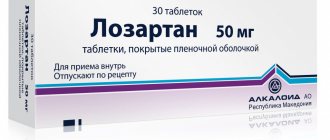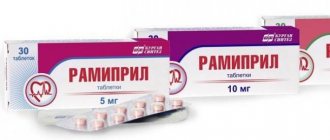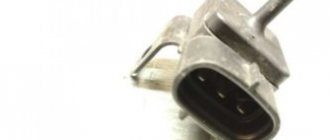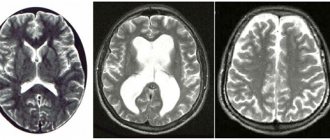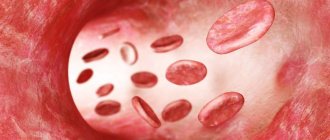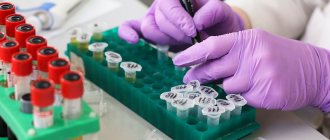Compound
- 1 tablet of Liprazide 10 contains 12.5 mg of hydrochlorothiazide and 10 mg of lisinopril. Additional substances: corn starch, mannitol, yellow iron oxide, magnesium stearate, calcium hydrogen phosphate dihydrate.
- 1 tablet of Liprazide 20 contains 12.5 mg of hydrochlorothiazide and 20 mg of lisinopril. Additional substances: corn starch, mannitol, yellow iron oxide, magnesium stearate, calcium hydrogen phosphate dihydrate.
Pharmacodynamics and pharmacokinetics
Pharmacodynamics
An antihypertensive drug of a combined composition containing angiotensin-converting enzyme inhibitor lisinopril and a thiazide-type diuretic - hydrochlorothiazide.
Lisinopril inhibits angiotensin-converting enzyme , which transforms angiotensin type 1 into angiotensin type 2. A decrease in the concentration of angiotensin type 2 leads to a decrease in aldosterone , which causes a decrease in peripheral resistance of blood vessels and blood pressure.
Hydrochlorothiazide is a thiazide diuretic with moderate antihypertensive effects. Reduces the reabsorption of electrolytes and water in the kidney tubules, increases diuresis, which reduces the amount of circulating blood and reduces the increased pressure. A significant decrease in systolic and diastolic pressure occurs 3-4 days after the start of taking hydrochlorothiazide , and the optimal effect is observed after 3-4 weeks.
The combination of lisinopril and hydrochlorothiazide causes a stronger hypotensive effect than using each component separately.
Pharmacokinetics
The bioavailability of lisinopril reaches 30%. Eating food together with taking the drug does not affect the absorption of lisinopril . A small amount (7-10%) reacts with blood proteins. The first effect after using lisinopril is recorded after 1 hour, the highest level in the blood is achieved six hours after use. Only about 7% of the dose is metabolized in the liver. Partially penetrates the placenta. Most of the substance is excreted in its original form by the kidneys. The half-life from the blood reaches 12 hours. The evacuation of lisinopril in elderly patients is slowed down.
The diuretic effect of hydrochlorothiazide is recorded 2 hours after application, reaches its greatest severity after 4 hours and lasts up to 12 hours. Bioavailability is no more than 70%. Up to 40% of the dose is bound to blood . Passes through the placenta and is excreted into breast milk during lactation . Not metabolized, excreted in urine.
When will the effect occur?
The effect of using Almag 01, as a rule, does not occur immediately. This largely depends on the disease you want to treat. The device must be used regularly. The course, depending on the disease and its nature, can range from 10 to 20 procedures; its duration must be discussed with a doctor.
Usually the effect can be felt after several treatments. But in some cases it will be necessary to undergo a full course of treatment, and sometimes a repeated course of treatment is necessary.
Contraindications
- Hereditary or cryptogenic angioedema , including those caused by the use angiotensin-converting enzyme inhibitors .
- Sensitization to the components of the drug, other angiotensin-converting enzyme blockers or sulfonamide derivatives.
- Hypertrophic cardiomyopathy due to hemodynamic disturbances.
- Aortic or mitral stenosis .
- Bilateral artery stenosis or stenosis of the artery of a single kidney.
- Cardiogenic shock.
- Myocardial infarction in the acute period with unstable hemodynamics.
- Condition after kidney transplant.
- Severe renal failure .
- Mechanical obstruction of the urinary tract.
- Disorders of water-salt metabolism.
- Hemodialysis using high-strength membranes.
- Severe diabetes mellitus .
- Hepatic encephalopathy.
- Severe liver failure.
- Primary hyperaldosteronism.
- Anuria.
- Porphyria.
- Exacerbation of gout .
Instrument statistics
Clinical studies have shown that during a course of using the Almag 01 device, the following is observed:
- in 27.6% of patients there was a marked improvement;
- 51.4% of patients had moderate improvement;
- in 21% of patients there was a slight improvement.
No deterioration of the condition was recorded.
Specialists from City Clinical Hospital No. 11 7 (Ryazan) used the device to treat patients suffering from benign hyperplasia. As a result, in more than 90% of patients, pain in the genital area decreased or disappeared, and in many patients with symptoms of sexual disorders, restoration of copulatory function was noted.
In the Central Park of the State Military Clinical Hospital named after. Academician N. N. Burdenko “Almag 01” was used to treat injuries. Studies have shown that treatment times were reduced by approximately 10% compared to a control group of patients who did not participate in sessions using the device.
Side effects
- Circulatory phenomena: arterial hypotension, myocardial infarction, fainting, secondary cerebrovascular accidents due to a significant decrease in pressure, tachycardia, palpitation, bradycardia, arrhythmia, angina pectoris, chest pain, impaired AV conduction, necrotizing vasculitis, Raynaud's syndrome.
- Phenomena from nervous activity: dizziness , imbalance, loss of consciousness, headache , disorientation in space, symptoms of depression , mood lability, decreased appetite , changes in taste, anorexia , impaired sense of smell, impaired concentration, apathy , slowed thinking, paresthesia , increased fatigue, vertigo, asthenic syndrome , general weakness, drowsiness , convulsions , confusion, agitation, irritability, anxiety, insomnia .
- Digestive phenomena: decreased appetite, heartburn , increased thirst , vomiting, nausea, sialorrhea , abdominal pain, dyspepsia, diarrhea, constipation, stomatitis, glossitis, hepatic encephalopathy, cholecystitis , dry mouth, sialoadenitis, hepatitis, pancreatitis , liver failure , jaundice, hepatic coma .
- Respiratory phenomena: changes in breathing rhythm, dry cough , rhinitis, bronchitis, sinusitis, distress syndrome, allergic pneumonia, bronchospasm, shortness of breath , respiratory tract infections.
- Skin phenomena: hair loss, increased sweating, pemphigoid reactions, psoriasis, skin hyperemia, epidermal toxic necrolysis, erythema multiforme, eczema, photosensitivity, purpura, exacerbation of systemic lupus erythematosus , exfoliative dermatitis, pseudolymphoma of the skin.
- Hematopoietic phenomena: decreased hemoglobin and hematocrit, anemia, leukopenia, leukocytosis, erythrocytopenia, thrombocytopenia, purpura, eosinophilia, neutropenia, lymphadenopathy, agranulocytosis, myelosuppression.
- Genitourinary phenomena: renal dysfunction, uremia, glucosuria, polyuria, acute renal failure, anuria, oliguria, interstitial nephritis , decreased potency, gynecomastia .
- Immune phenomena: anaphylactic shock, anaphylactic reactions, autoimmune diseases.
- Allergic phenomena: itching , angioedema , difficulty swallowing, urticaria .
- Changes in laboratory data: changes in electrolyte balance ( hypochloremia, hypomagnesemia, hyponatremia, hypokalemia, hypercalcemia), hyperuricemia, hyperglycemia, hyperkalemia, hypercholesterolemia , increased urea and creatinine, hyperbilirubinemia, hypertriglyceridemia , increased concentrations of liver enzymes, proteinuria , decreased sensitivity to glucose , increased erythrocyte sedimentation rate .
- Other phenomena: arthritis , increased body temperature, muscle spasms, gout , muscle pain, xanthopsia, temporary decrease in visual acuity, conjunctivitis , tinnitus, diabetes mellitus, hypochloremic alkalosis, ear pain.
Instructions for use of Liprazide (Method and dosage)
The instructions for use of Liprazide 20 and the instructions for use of Liprazide 10 are fundamentally similar and recommend taking the medicine taking into account the dosages of lisinopril and hydrochlorothiazide used in monotherapy. The dose is selected individually, taking into account the therapeutic effect.
The initial dose is 5-10 mg per day in terms of lisinopril , subsequently the dose is changed taking into account the recorded clinical effect. A confident therapeutic effect is usually noticeable after 2-4 weeks from the start of using the drug. The maintenance dose is usually 20 mg once daily. The highest daily dose is 40 mg in terms of lisinopril .
Which side should you apply Almag 01 to your body?
To use the medical device correctly, you need to figure out how to apply Almag 01. It is important to know the following:
- the device consists of four inductors superimposed on the problem area;
- due to design features, both surfaces (flat sides) of each inductor are working, which means that it makes no difference which side the device is applied to the body;
- inductor coils should not be twisted together by 180 °
- before the procedure you need to choose a comfortable position;
- treatment can be carried out through light clothing, as well as through a dry bandage of plaster or gauze.
Instructions for use of the device "Almag 01"
If you do not know how to use Almag 01, the instructions for using the device will definitely be useful to you. Please read it carefully before starting treatment.
Technical characteristics of the device ALMAG-01:
| The device is powered from an alternating current network | frequency 50 Hz, voltage 220 V (- 10%, + 10%) or 230 V (- 10%, + 6%) |
| Power consumed by the device from the network, no more | 35 W |
| Weight of the device no more than | 0.62 kg |
| Overall dimensions of the device | |
| — electronic unit | 137 x 60 x 45 mm |
| — impact unit (one of the coils) | 15 x 90 mm |
| Number of impact nodes | 4 |
| The amplitude value of the magnetic induction on the working surface (both flat sides) of the inductor coil of the coil group of the device is | (20 ± 6) mT |
| The pulse duration is | 1.5 - 2.5 ms |
| Repetition frequency of magnetic field pulses in each coil | 6 Hz |
| The device provides operation in intermittent mode for 6 hours | operating time (22±1) min., break 10 min. |
| The device automatically disconnects from the network after | (22±1) min |
| Mean time between failures | not less than 1000 h |
| Average service life | 5 years |
Schematic electrical diagram of "Almag 01"
People planning to use the Almag 01 device will find its diagram useful. It can be seen that the device consists of several main elements. This:
- electronic unit responsible for generating current pulses;
- influence unit - four inductor coils, which are connected to each other and are used to influence parts of the body affected by various diseases;
- cable;
- power cord.
The electronics housing is made of polystyrene, a lightweight, impact-resistant material.
When you connect the medical device to the network, two light indicators on the body light up:
- green indicates that the device is connected to the network;
- yellow indicates that the device is working - thanks to the connection with the timer, it goes out 20 minutes after turning on Almag 01 to the network, and the influence of the device stops, that is, the magnetic field is no longer generated.
The electrical circuit of the device is designed in such a way that for its full functioning, a break of at least 10 minutes is required between 20-minute sessions.
Equipment
Package Included:
- apparatus "Almag 01";
- magnetic field indicator;
- additional fastening elements;
- user manual.
Principle of operation
The operating principle of the Almag 01 medical device is based on the use of a traveling pulsed magnetic field (TPMF). Any magnetic fields can have a healing effect on the human body, enhancing intercellular and intracellular exchange 1.
However, the BIMP has an important feature: its pulses fall in the range from 4 to 16 Hz. According to the research of the American biologist W.R. Adey2, this is a range of biologically active frequencies characteristic of our body.
The device has a rhythmic effect on diseased organs and tissues. As a result:
- the electromagnetic characteristics of cells that have changed as a result of the disease are restored;
- the interaction between chemical elements participating in redox processes improves, and this, in turn, also leads to the restoration of impaired body functions.
The inductor coils of the device are designed in such a way that a traveling pulsed magnetic field can penetrate deep into tissue to a depth of 8 centimeters. Thanks to this, it is possible to treat diseases of organs located deep under the skin.
It is also important to note that the device improves blood flow at the site of treatment. It means that:
- blood viscosity decreases and, accordingly, the risk of blood clots decreases;
- The lumen of blood vessels increases, additional capillaries open, they become more permeable.
Blood supply in the area affected by the Almag 01 device is significantly improved. The cells are provided with the necessary oxygen, construction proteins and immunoglobulins, and inflammatory products are promptly removed from them. Metabolism is activated, this leads to the fact that regeneration processes proceed more quickly, cells are restored and renewed, and the progression of the disease slows down.
The nervous system is most susceptible to the effects of BIMPs. The use of Almag 01 helps stimulate inhibition processes, which provides a sedative (calming) effect. The device can be used to treat some cases of insomnia, as the magnetic field promotes healthy sleep.
The device normalizes the production and release into the blood of hormones in the brain structures that affect the function of endocrine organs. Thanks to this, you can use it to:
- correct some hormonal imbalances;
- create an anti-stress effect;
Also, the Almag 01 medical device effectively treats pain syndromes of various origins. This is ensured due to the fact that BIMP is able to reduce the sensitivity of peripheral nerve receptors, and this, in turn, causes gradual attenuation and complete disappearance of pain.
The device can also help people with cerebrovascular accidents. A running pulsed magnetic field reduces the tone of brain vessels and increases their lumen. This improves cerebral circulation and makes metabolism more active 3.
The medical device has a significant impact on the cardiovascular system. Thanks to it, the heart rate is normalized, blood vessels dilate, and blood flow improves. This allows, for example, to effectively combat hypertension.
The effect of BIMP stimulates metabolic processes, provides analgesic, anti-edematous, anti-inflammatory effects. Studies have shown that during a course of treatment using Almag 01, the number of leukocytes in the blood increases. This means that the device stimulates the work of the thymus gland, lymph nodes, spleen and other immunocompetent organs.
This medical device has another important feature. Regardless of what disease you are treating, during the treatment biologically active points are stimulated, which causes a reflex response in the muscles and internal organs associated with them. This also benefits the body4.
Any organism has such a characteristic as the level of adaptation. It can be defined as the ability to withstand the negative influences of the external environment, as well as the ability to self-heal. A course of treatment with Almag 01 not only provides a variety of therapeutic effects, but also leads to a smooth increase in the patient’s level of adaptation. This contributes to the treatment of not only acute but also chronic diseases.
The device "Almag 01"
The device is extremely simple. Its main elements are an electronic unit that generates current pulses, an impact unit, which includes four interconnected inductor coils, a cable and an electronic cord. All connections are flexible and permanent5.
There are two indicators on the electronic unit housing. Green indicates that the device is connected to the network, yellow indicates that the device is working. The yellow indicator is connected to a timer and stops generating a magnetic field 20 minutes after being connected to the network. If the yellow indicator goes out, you need to turn off Almag 01 and reconnect it to the power supply after at least 10 minutes.
Inductor coils are used directly to influence the human body. Each of them has two working surfaces. This means that it makes no difference which side you apply them to.
To determine whether the device is in working order, use the magnetic field indicator included in the package. Apply it alternately to the working surfaces of the coils. It will indicate that the device is working by flashing a light or vibrating (depending on the specific type of indicator included with your device).
If you connect the device to the power supply and it is working properly, then the electronic unit begins to generate current pulses, which are distributed over coils that convert them into magnetic induction pulses. As a result, a traveling pulsed magnetic field is created in the direction from the first coil to the fourth. It provides the therapeutic effect the patient needs.
Magnetic field indicator in Almag-01
What is the included magnetic field indicator used for? This is an important additional device. The indicator will show whether the Almag 01 device is working.
How to use the device? To check the functionality of the device, it is enough:
- connect “Almag 01” to the network;
- put the indicator on the work surface - you can select any of the four coils.
If everything is in order with the device, it is connected to the network and generates a magnetic field, the light on the indicator body will begin to blink. If this does not happen, check that you have inserted the plug well into the outlet. If the light does not blink, this may mean the following:
- problems with connecting to the electrical network;
- device malfunction;
- indicator malfunction.
Some devices come with an indicator that indicates the operation of the device not by flashing a light bulb, but by vibration.
If Almag 01 does not work and the warranty period has not yet expired, you need to contact the store where you purchased it. They will exchange your faulty device for a new one or help you send it to a service center so that specialists can fix the problem.
Overdose
Signs of overdose: headache, hypotension , dizziness, drowsiness, anxiety, weakness, fatigue, impaired consciousness, cough, dry mouth, thirst, vomiting, nausea, hyperventilation, bradycardia, tachycardia, arrhythmia , leg muscle cramps, cardiovascular shock , disorders of water-electrolyte balance and acid-base imbalance ( hypokalemia, dehydration, hypochloremia, hyponatremia, alkalosis ), paresthesia , increased urea in the blood, oliguria, polyuria, acute renal failure, anuria.
Treatment of overdose: symptomatic and supportive treatment; no specific antidote is known. Gastric lavage is effective if no more than 4 hours have passed since taking the drug. If necessary, provide air access or perform artificial respiration. It is also recommended to carry out measures aimed at normalizing water and electrolyte balance. When the pressure decreases, the patient is transferred to a horizontal position with his legs elevated, and an infusion of sodium chloride solution is performed.
Lisinopril is evacuated during hemodialysis , but the use of polyacrylonitrile high-flow membranes for dialysis should be avoided due to the risk of anaphylactoid reactions . For the treatment of persistent bradycardia, the use of a pacemaker is recommended.
When angioedema , a subcutaneous injection of 0.3-0.5 ml of epinephrine in the form of a solution and the use of desensitizing agents are indicated.
Safety precautions when working with the device
- Before using the device, be sure to carefully read the instruction manual.
- Inspect the device. Make sure that the housing, inductors and cables are not damaged. If there is any damage, the Almag 01 device must not be used under any circumstances.
- The device can only be connected to a working electrical outlet. Sockets with an operating voltage of ~220V (-10%, +10%) or ~230V (-10%, +6%) and a frequency of 50 Hz are suitable. Make sure that the network cable is not stretched to the limit when connecting.
- Protect the device from dampness, shock and shock. When treating the device with a disinfectant solution, avoid getting moisture inside the inductor coils and the electronic unit.
Precautions for therapeutic effects
- The duration of the first procedure is 10 minutes or even less.
- When treating two zones, the total exposure time is no more than 30 minutes.
- If an effect on the cervicothoracic spine is necessary, the duration of the first three procedures is no more than 10 minutes.
- Direct effects on the heart and brain are prohibited.
The device cannot:
- lift and carry by the power cord;
- place next to magnetic storage media and magnetically sensitive devices (audio, video equipment and other similar devices).
How to check the functionality of the Almag 01 device?
The delivery set includes a special device - a magnetic field indicator. It is intended to test the functionality of the Almag 01 device. It's very easy to use:
- turn on the device;
- place the indicator on the working surface of the coil;
- Wait until the indicator blinks or vibrates (depending on which model is included in your kit).
If the indicator does not react in any way when the device is turned on, then something is wrong with the device.
Interaction
When using lisinopril with:
- lithium preparations temporarily increase the lithium in the blood and develop a toxic effect;
- anti-inflammatory non-steroidal drugs weaken the antihypertensive effect, hyperkalemia and deterioration of kidney function - this effect is usually reversible;
- Allopurinol increases the risk of renal dysfunction and leukopenia ;
- Lovastatin increases the risk of hyperkalemia ;
- Heparin, Cyclosporine, trimethoprim increases the likelihood of deterioration of kidney function and the appearance of hyperkalemia ;
- cytostatics, immunosuppressants, Procainamide increases the risk of leukopenia ;
- sympathomimetic agents may weaken the hypotonic effect of angiotensin-converting enzyme inhibitors ;
- tricyclic antidepressants, painkillers and antipsychotics increase hypotension ;
- hypoglycemic agents may reduce blood glucose
- Potassium-sparing diuretics and potassium supplements increase the risk of hyperkalemia ;
- diuretics enhance the antihypertensive effect;
- loop diuretics (Furosemide, ethacrynic acid) may develop arterial hypotension of varying severity;
- corticosteroids and estrogens may weaken the antihypertensive effect of the drug;
- antacids are likely to worsen the bioavailability of lisinopril .
Lisinopril is allowed to be prescribed together with thrombolytics, acetylsalicylic acid, β-blockers and nitrates.
When using hydrochlorothiazide with:
- non-depolarizing muscle relaxants stimulate the action of the latter and increase sensitivity to tubocurarine ;
- cardiac glycosides may increase the likelihood of side effects of the latter as a result of hypokalemia and hypomagnesemia ;
- drugs that cause fluctuations in the level of potassium in the blood (antiarrhythmic drugs of classes 1 and 3, antipsychotics and some others), the risk of cardiac arrhythmias ;
- Difluzanil increases the content of hydrochlorothiazide in the blood and decreases its hyperuricemic effect;
- anti-inflammatory non-steroidal drugs weaken the antihypertensive, natriuretic and diuretic effects of thiazides , increasing the risk of renal dysfunction;
- Diazepam, ethanol, narcotic analgesics, barbiturates, antidepressants are likely to enhance the hypotensive effect of hydrochlorothiazide ;
- lithium salts increase the content of lithium salts in the blood to toxic levels;
- pressor amines and norepinephrine weaken their effect on blood pressure;
- hypoglycemic drugs may reduce blood glucose hypoglycemia ;
- Sulfinpyrazone, Probenecid and Allopurinol may require dosage adjustment of uricosuric drugs , since hydrochlorothiazide increases uric acid in the blood;
- other antihypertensive drugs increase their effect;
- cytotoxic drugs worsen the renal excretion of the latter, as a result of which their myelosuppressive effect increases;
- salicylates enhance their toxic effect on the nervous system;
- anticholinergic drugs increase the bioavailability of thiazide-type diuretics;
- Cyclosporine increases the risk of hyperuricemia and gout;
- beta blockers and Diazoxide are likely to enhance their hyperglycemic effect;
- Amphotericin B, laxatives, motility stimulants, Calcitonin, glucocorticosteroids, adrenocorticotropic hormone worsen electrolyte imbalance;
- Vitamin D and calcium salts calcium excretion and increase its level in the blood;
- Trimethoprim increases the likelihood of developing hyperkalemia ;
- Carbamazepine may develop hyponatremia ;
- sympathomimetics may reduce the hypotensive effect;
- Digoxin increases the toxicity of the latter;
- tetracyclines or activated carbon weaken the absorption of hydrochlorothiazide ;
- Quinidine increases the possibility of ventricular fibrillation .
special instructions
Arterial hypotension and water-electrolyte imbalance
In patients with dehydration and electrolyte imbalance due to diuretic symptomatic arterial hypotension may develop after using Liprazid . To prevent such phenomena, diuretics should be stopped 3 days before starting Liprazide therapy.
Surgery and general anesthesia
You should be careful when using Liprazide by persons who are planning surgery under general anesthesia, since during major operations and the use of other antihypertensive drugs, lisinopril can cause a pronounced decrease in pressure.
Metabolic and hormonal effects
Treatment with thiazides glucose tolerance . The need to regulate the dosages of antidiabetic drugs cannot be ruled out.
Increases in triglyceride and cholesterol may be caused by thiazide therapy .
Thiazides may also calcium and cause a slight increase in serum calcium . thiazides before the proposed examination of the parathyroid glands.
Hypersensitivity
Although angioedema has rarely occurred in patients taking angiotensin-converting enzyme inhibitors , this reaction can occur at any time. In such cases, the use of Liprazid should be stopped immediately and emergency care should be sought immediately.
While using the drug, it is possible that the course of connective tissue diseases may worsen.
Cough
A characteristic persistent nonproductive cough can occur with the use of angiotensin-converting enzyme inhibitors and disappears after their discontinuation.
Hemodialysis patients
The drug is contraindicated for the treatment of patients undergoing hemodialysis and is not prescribed to persons with a transplanted kidney.
Liver diseases
Very rarely, when using Liprazide, a syndrome may occur that begins with cholestatic jaundice or hepatitis and can progress to liver necrosis . If patients develop jaundice or significantly increase the level of liver enzymes, then Liprazide should be immediately discontinued and the patient should be taken under medical supervision until the symptoms disappear.
The antihypertensive effect of the drug may increase after sympathectomy .
While taking hydrochlorothiazide, false-positive results may occur during anti-doping control.
During treatment with Liprazide, it is recommended to limit exposure to direct sunlight due to the risk of photosensitivity .
Liprazid 10 tablets for high blood pressure, 30 pcs.
Non-melanoma skin cancer
An increased risk of nonmelanoma skin cancer (NMSC) with increasing cumulative dose of HCTZ was found in two pharmacoepidemiological studies. The photosensitizing effect of HCTZ may act as a possible mechanism for the development of this pathology.
Patients taking HCTZ alone or in combination with other drugs should be informed of the risk of developing NMSC, especially with long-term use, the need for regular skin checks, and to immediately report new lesions or any suspicious skin lesions, changes in skin lesions or moles.
To reduce the risk of developing skin cancer, patients should be advised of possible preventive measures, such as limiting exposure to sunlight and UV radiation, and if exposed, the need for adequate skin protection. It is necessary to examine suspicious skin lesions as soon as possible, including histological examination of biopsy material.
Patients with a previous history of NMSC may also need to review the use of HCTZ.
Symptomatic hypotension
Symptomatic hypotension is rare in patients with uncomplicated hypertension and is more likely in patients with hypovolemia, electrolyte imbalance (including hyponatremia, hypochloremic alkalosis, hypomagnesemia or hypokalemia), for example, during diuretic therapy, low-salt diet, dialysis, diarrhea , vomiting or in severe forms of renin-dependent hypertension. Such patients should undergo regular determination of serum electrolytes. In patients at increased risk of symptomatic hypotension, initiation of therapy and dose adjustment should be carried out under close medical supervision. Particular attention is necessary for patients with coronary heart disease or cerebrovascular diseases, in whom an excessive decrease in pressure can lead to myocardial infarction or stroke.
If arterial hypotension develops, the patient should be placed on his back and, if necessary, given an intravenous infusion of saline sodium chloride solution. Transient arterial hypotension when taking the drug is not a contraindication for its further use. After normalization of blood pressure and restoration of effective blood volume, it is possible to resume therapy with the drug lisinopril / hydrochlorothiazide in a reduced dosage or separately with one of the components.
In some patients with heart failure and normal or low blood pressure, lisinopril may further reduce systemic blood pressure. This effect is expected and is not usually a reason to stop treatment. If symptomatic hypotension may require dose reduction or discontinuation of the lisinopril/hydrochlorothiazide combination drug.
Dual blockade of renin-angiotensin (RAAS)
Concomitant use of ACE inhibitors (including lisinopril), angiotensin II receptor blockers (ARBs) or aliskiren increases the risk of arterial hypotension, hyperkalemia and decreased renal function (including acute renal failure). Therefore, dual blockade of the RAAS by combining ACE inhibitors with ARBs or aliskiren is not recommended.
If double blockade of the RAAS is considered absolutely necessary, this should only occur under specialist supervision and with frequent careful monitoring of renal function, blood electrolyte levels (especially potassium), and blood pressure.
ACE inhibitors and ARBs should not be used concomitantly in patients with diabetic nephropathy.
Previous diuretic therapy
Symptomatic hypotension may occur after the initial dose of the lisinopril/hydrochlorothiazide combination drug. This is more likely in patients with dehydration and/or salt deficiency as a result of previous diuretic therapy. Diuretic therapy should be discontinued 2-3 days before starting the lisinopril/hydrochlorothiazide combination. If this is not possible, treatment should be started with lisinopril 5 mg alone.
Aortic and/or mitral valve stenosis/hypertrophic cardiomyopathy
Like other ACE inhibitors, lisinopril is not recommended for use in patients with mitral valve stenosis and left ventricular outflow obstruction (for example, aortic stenosis or hypertrophic cardiomyopathy).
Renal dysfunction
Thiazides may not be acceptable diuretics for use in patients with impaired renal function. They are ineffective when CC is 30 ml/min or lower (moderate or severe renal failure).
The combination drug lisinopril/hydrochlorothiazide should not be used as initial therapy in any patient with impaired renal function.
Lisinopril/hydrochlorothiazide should not be prescribed to patients with renal impairment (creatinine clearance ≤ 80 ml/min) until the need for the exact doses contained in the combination tablet has been established by titrating the doses of the individual active substances of the drug.
In patients with heart failure, arterial hypotension that occurs after initiation of therapy with ACE inhibitors can lead to further impairment of renal function with the possible subsequent development of reversible (after discontinuation of the drug) acute renal failure.
Some patients with arterial hypertension without obvious signs of kidney disease may experience slight transient increases in serum urea and creatinine levels, especially if lisinopril is used concomitantly with diuretics. The likelihood of this happening is higher in patients with pre-existing renal impairment. This condition may require dose reduction and/or discontinuation of the diuretic and/or lisinopril.
Patients after kidney transplantation
There is no experience with the use of the drug in patients with a recently transplanted kidney, so the drug should not be used in this group of patients.
Anaphylactoid reactions during hemodialysis
The use of lisinopril/hydrochlorothiazide is not indicated in patients who require dialysis for renal failure.
Cases of anaphylactic reactions have been reported in patients undergoing hemodialysis procedures using high-flow membranes (for example AN 69) and concomitant treatment with ACE inhibitors. In such patients, it is recommended to use a different type of dialysis membrane or a different class of antihypertensive drugs.
Anaphylactoid reactions during low-density lipoprotein (LDL) apheresis
Life-threatening anaphylactic reactions have been rarely reported in patients receiving ACE inhibitors during LDL apheresis with dextran sulfate. To avoid these reactions, ACE inhibitors should be temporarily suspended before each apheresis procedure.
Liver diseases
Thiazides should be used with caution in patients with impaired liver function or progressive liver disease, since minor changes in fluid and electrolyte balance may precipitate sudden hepatic coma.
Very rarely, the use of ACE inhibitors has been associated with a syndrome that begins with cholestatic jaundice or hepatitis and progresses to fulminant hepatic necrosis, sometimes fatal. The mechanism of this syndrome is unknown. If patients taking lisinopril/hydrochlorothiazide develop jaundice or significantly increased serum liver enzymes, the drug should be discontinued and the patient should be monitored until symptoms resolve.
Surgery/general anesthesia
During major surgery or during anesthesia with drugs that cause hypotension, lisinopril can block the formation of angiotensin II due to compensatory release of renin, causing a pronounced, unexpected decrease in blood pressure. If arterial hypotension develops, which can be explained by this mechanism, it should be corrected by increasing the volume of blood volume.
Metabolic and endocrine effects
It is known that the combined use of ACE inhibitors and antidiabetic drugs (including insulin) can cause an increase in blood glucose concentrations and reduces the risk of hypoglycemia. This phenomenon is more likely to develop in the first weeks of combination therapy and in patients with impaired renal function (see Section “Interaction with other drugs and other types of interactions”). Thiazide therapy can lead to impaired glucose tolerance and the development of hyperglycemia. Therefore, dosage adjustments of antidiabetic agents, including insulin, may be necessary. In diabetic patients receiving oral antidiabetic agents or insulin, plasma glucose levels should be carefully monitored during the first month of treatment with an ACE inhibitor. Manifestation of latent diabetes mellitus is possible during thiazide therapy.
Thiazide diuretic therapy may be associated with increased levels of cholesterol, free bilirubin (due to displacement from albumin) and triglycerides in the blood plasma.
Thiazides can reduce plasma levels of protein-bound iodine without evidence of thyroid dysfunction.
In some patients, the use of thiazide diuretics may provoke hyperuricemia and/or worsen the course of/provoke an attack of gout in predisposed patients. However, lisinopril may increase the excretion of uric acid and thus may reduce the hyperuricemic effect of hydrochlorothiazide.
Electrolyte imbalance
All patients receiving diuretic therapy should have serum electrolyte levels measured periodically to identify possible fluid and electrolyte imbalances.
Thiazides, including hydrochlorothiazide, can cause water and electrolyte imbalance, incl. hypovolemia, hyponatremia, hypokalemia, hypomagnesemia, hypochloremic alkalosis. Determination of serum and urine electrolyte levels is especially important when the patient is experiencing excessive vomiting and/or diarrhea or is receiving parenteral fluids. Warning symptoms of fluid and electrolyte imbalance, regardless of the cause, are dry mouth, thirst, weakness, lethargy, drowsiness, restlessness, confusion, cramps, muscle pain or cramps (Crump), muscle fatigue, hypotension, oliguria, tachycardia, nausea , vomit.
The drug should be prescribed with caution to patients who are on a salt-free diet.
In patients with edema in hot weather, dilutional hyponatremia may occur. Chloride deficiency is usually minor and does not require treatment. Thiazides increase urinary excretion of magnesium, which can lead to hypomagnesemia.
Thiazides can also reduce the excretion of calcium in the urine and, as a result, cause a slight transient increase in its level in the blood plasma. Significant hypercalcemia may be a manifestation of latent hyperparathyroidism. Thiazides should be discontinued before testing parathyroid function.
Hyperkalemia
Some patients taking ACE inhibitors, including lisinopril, experienced an increase in serum potassium concentrations. Risk factors for hyperkalemia include renal failure, diabetes mellitus, concomitant use of potassium-sparing diuretics, potassium-containing dietary supplements or potassium-containing salt substitutes or other drugs that cause an increase in serum potassium concentrations (for example, heparin, trimethoprim). If taking the above-mentioned drugs during treatment with ACE inhibitors is considered necessary, regular monitoring of serum potassium levels is recommended.
Monitoring blood electrolyte levels is particularly important in patients receiving potassium-sparing diuretics and ACEIs or ARBs for heart failure. Also in such cases, the lowest effective doses of potassium-sparing diuretics and ACEIs/ARBs should be used. In case of hyperkalemia, suspension or discontinuation of treatment should be considered.
Diabetes
Patients taking oral antidiabetic agents or insulin should exercise close glycemic control, especially during the first month of treatment with ACE inhibitors.
Hypersensitivity/angioedema
Angioedema of the face, extremities, lips, tongue, epiglottis, vocal cords and/or larynx has been observed in isolated cases in patients treated with ACE inhibitors, including lisinopril. Angioedema may develop at any time during treatment. In this case, the use of lisinopril should be stopped immediately, appropriate treatment should be administered and the patient should be monitored until symptoms disappear completely.
Even in cases where swelling is limited to the tongue and there are no signs of respiratory distress, patients may require long-term observation as treatment with antihistamines and corticosteroids may not be sufficient.
Very rarely, deaths due to angioedema of the larynx or tongue have been reported. If swelling extends to the tongue, vocal cords, or larynx, airway obstruction may occur, especially in patients who have previously had respiratory surgery. In such cases, emergency treatment measures (administration of adrenaline (epinephrine) and/or maintaining airway patency) should be taken immediately. The patient should be under close medical supervision until symptoms disappear completely and permanently.
Angioedema with the use of ACE inhibitors occurred more often in representatives of the Negroid race than in patients of other races.
Patients with a history of angioedema not related to ACE inhibitor therapy may have an increased risk of developing it when using ACE inhibitors.
Patients receiving thiazides may experience hypersensitivity reactions (with or without a history of allergies or bronchial asthma). The use of the drug may worsen the course of connective tissue diseases, incl. systemic lupus erythematosus.
Anaphylactoid reactions during desensitization therapy
In patients receiving ACE inhibitors, prolonged anaphylactoid reactions developed during desensitizing therapy with allergens (for example, hymenoptera venom). By abstaining from taking ACE inhibitors during desensitization, such reactions can be avoided, but accidental repeated administration of ACE inhibitors again provoked the development of anaphylactoid reactions.
Neutropenia / agranulocytosis / thrombocytopenia / anemia
Cases of neutropenia/agranulocytosis, thrombocytopenia and anemia have been reported in patients taking ACE inhibitors. With normal renal function and in the absence of any other predisposing factors, neutropenia rarely develops. Neutropenia and agranulocytosis are reversible after discontinuation of ACE inhibitors.
Lisinopril should be used with particular caution in patients with diffuse connective tissue diseases, those being treated with immunosuppressants, allopurinol or procainamide, or a combination of these complicating factors, especially in the presence of pre-existing renal impairment.
Some of these patients developed severe infections that sometimes did not respond to intensive antibiotic therapy. When using lisinopril in such patients, it is recommended that the white blood cell count be periodically monitored, and patients should be warned to inform the physician of any signs of infection.
Choroidal effusion, acute myopia and secondary glaucoma
Hydrochlorothiazide, which is part of the drug, can cause an idiosyncratic reaction, which leads to the appearance of choroidal effusion with a visual field defect, the development of acute transient myopia and acute angle-closure glaucoma. Symptoms are characterized by an acute onset of decreased visual acuity and/or ocular pain and usually develop within hours to several weeks from the start of hydrochlorothiazide treatment.
Untreated acute glaucoma can lead to permanent vision loss. The first step is to stop using hydrochlorothiazide as soon as possible. Prompt medical or surgical treatment should subsequently be considered if intraocular pressure remains uncontrolled. A history of allergy to sulfonamides or penicillins may be a risk factor for the development of acute angle-closure glaucoma.
Ethnic characteristics
Blacks taking ACE inhibitors were more likely to experience angioedema compared to patients of other races. As with other ACE inhibitors, the antihypertensive effect of lisinopril is less pronounced in patients of the Black race than in patients of other races, possibly due to the greater prevalence of individuals with low blood renin levels among hypertensive Black patients.
Cough
During treatment with ACE inhibitors, the occurrence of a non-productive persistent cough has been reported, which resolves after discontinuation of the drug. Cough caused by ACE inhibitors should be differentiated from cough caused by other diseases.
Primary hyperaldosteronism
In patients suffering from primary hyperaldosteronism, ACE inhibitors are ineffective and should not be used in this group of patients.
Lithium
Concomitant use of lithium and lisinopril is generally not recommended.
Elderly patients
According to clinical studies, the effectiveness and tolerability of simultaneous use of lisinopril and hydrochlorothiazide were similar in both elderly patients and younger patients with arterial hypertension.
No dosage adjustment is required for elderly patients. If an elderly patient experiences decreased renal function, the initial dose of lisinopril should be adjusted (see "Renal failure").
Pregnancy
You should not start taking ACE inhibitors during pregnancy. If continued therapy with ACE inhibitors is considered necessary, patients planning pregnancy should be switched to alternative antihypertensive therapy with drugs that have an established safety profile for use during pregnancy. If pregnancy is diagnosed, treatment with ACE inhibitors should be stopped immediately and, if necessary, alternative therapy should be initiated (see Sections “Contraindications” and “Use during pregnancy or lactation”).
Photosensitivity
Photosensitivity reactions have been reported during treatment with thiazides. If photosensitivity occurs during treatment, it is recommended to discontinue the drug. If the doctor believes that the drug needs to be re-prescribed, it is recommended to protect areas of the body exposed to sunlight or artificial UV radiation and limit exposure to the sun.
Anti-doping test
The hydrochlorothiazide contained in this medicine may cause a false positive result in a doping test.
The antihypertensive effect of hydrochlorothiazide may be enhanced after sympathectomy.
During treatment with Liprazide, alcohol consumption is not recommended.
Analogs
Level 4 ATX code matches:
Akkuzid
Enap-N
Iruzid
Co-Diroton
Enalozide
Enap NL
Enapril-N
Capozide
Tritace Plus
Enzix
Co-Renitec
Hartil N
Hartil D
Noliprel
Ko-Perineva
Kaptopres
Iruzid, Co-Diroton, Lisinopril, Lisopress, Lisoretic, Lisothiazide, Lopril Bosnalek.
Price, where to buy
The price of Liprazid 10 No. 30 in Ukraine is about 64 hryvnia, and in Russia the price of a similar package is close to 306 rubles.
- Online pharmacies in UkraineUkraine
Pharmacy24
- Liprazide 20 No. 30 tablets PAT NEC "Borshchagivsky chemical and pharmaceutical plant", Kiev, Ukraine
66 UAH. order - Liprazide 10 N30 tablets PAT NEC "Borshchagivsky chemical and pharmaceutical plant", Kiev, Ukraine
50 UAH order
